In 1955, having attained the grand old age of 16 and somehow managed to pass 8 of the 9 GCE O-levels I had sat, I received a neat little blue and silver box as a reward for one or the other achievement, can’t remember which now. That beautiful little box contained my first camera of real quality. Fast forward 67 years and move to the other side of the world, the same little box arrived in my mail box.
It contained the same thing, a Voigtländer Vito IIa and ERC that I had found in the original one except for the “1756-1956” text which was added from 1956, to commemorate the firm’s 200 year history. Amazingly, the “new” one appeared to be, in fact, almost as new! The case in particular shows hardly any wear. The exceptions are a mysterious, small, pin sized dent on the top plate, the film reminder disk on the rewinder, which is slightly worn, and some chipped enamel on the back all out of character with the rest of the camera. I put this down to the parts having been swapped with their display model by the museum I bought it from, who were selling off their duplicates. It turned out, however, that, despite its near perfect cosmetic condition, its many years of inactivity had left the shutter speed ring very stiff and speeds that hung up. I didn’t even dare try the delayed action.
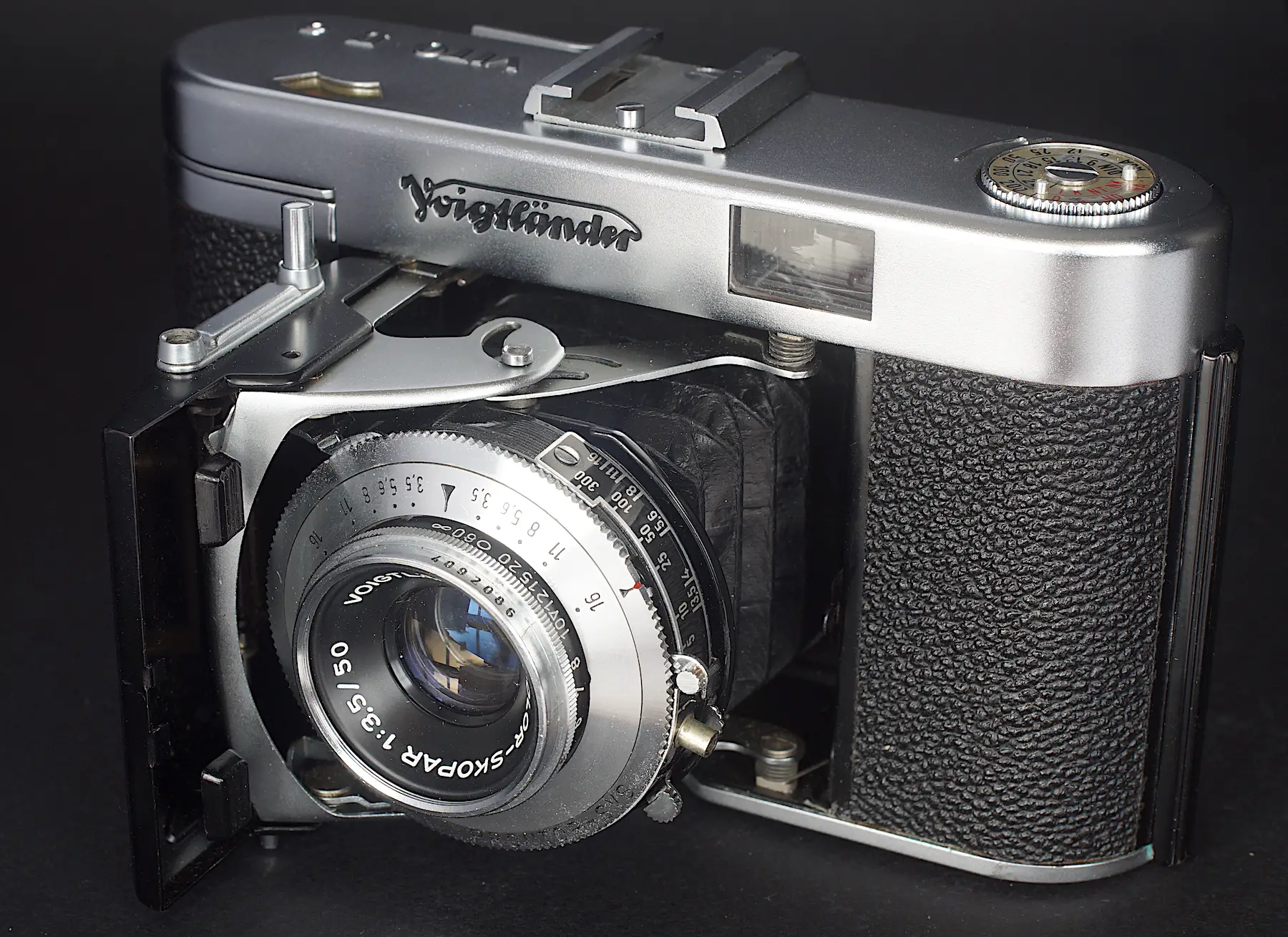
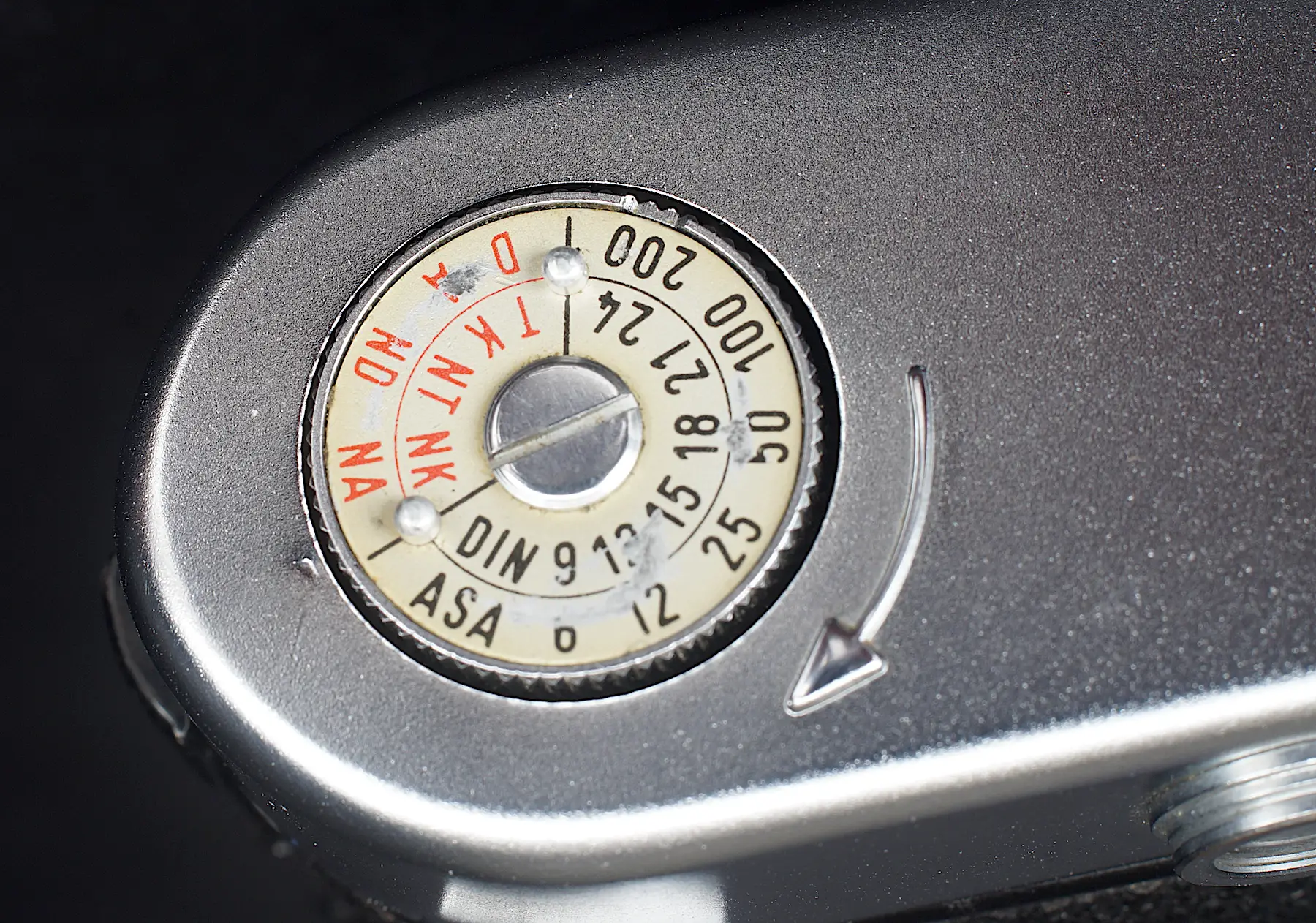
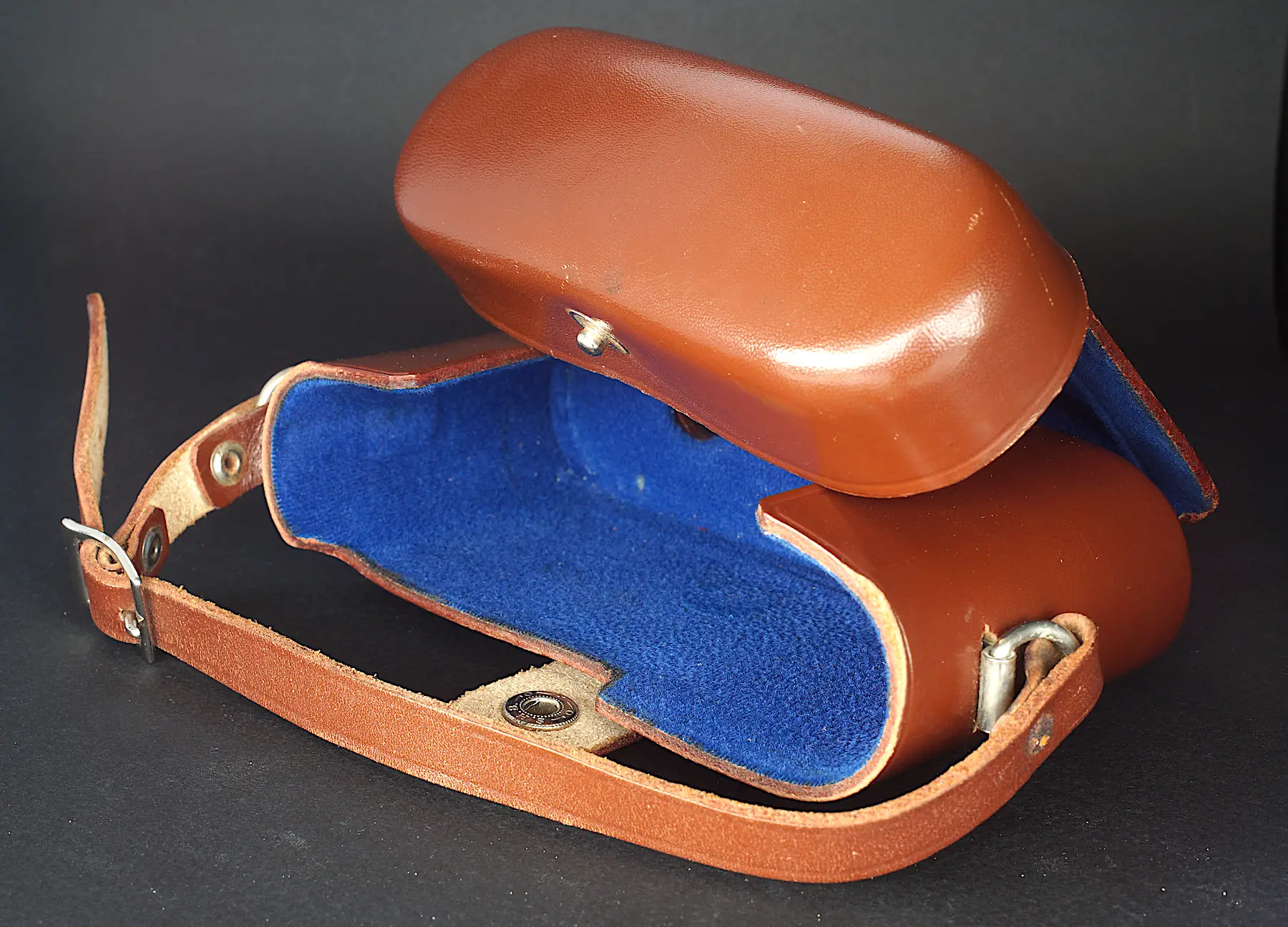
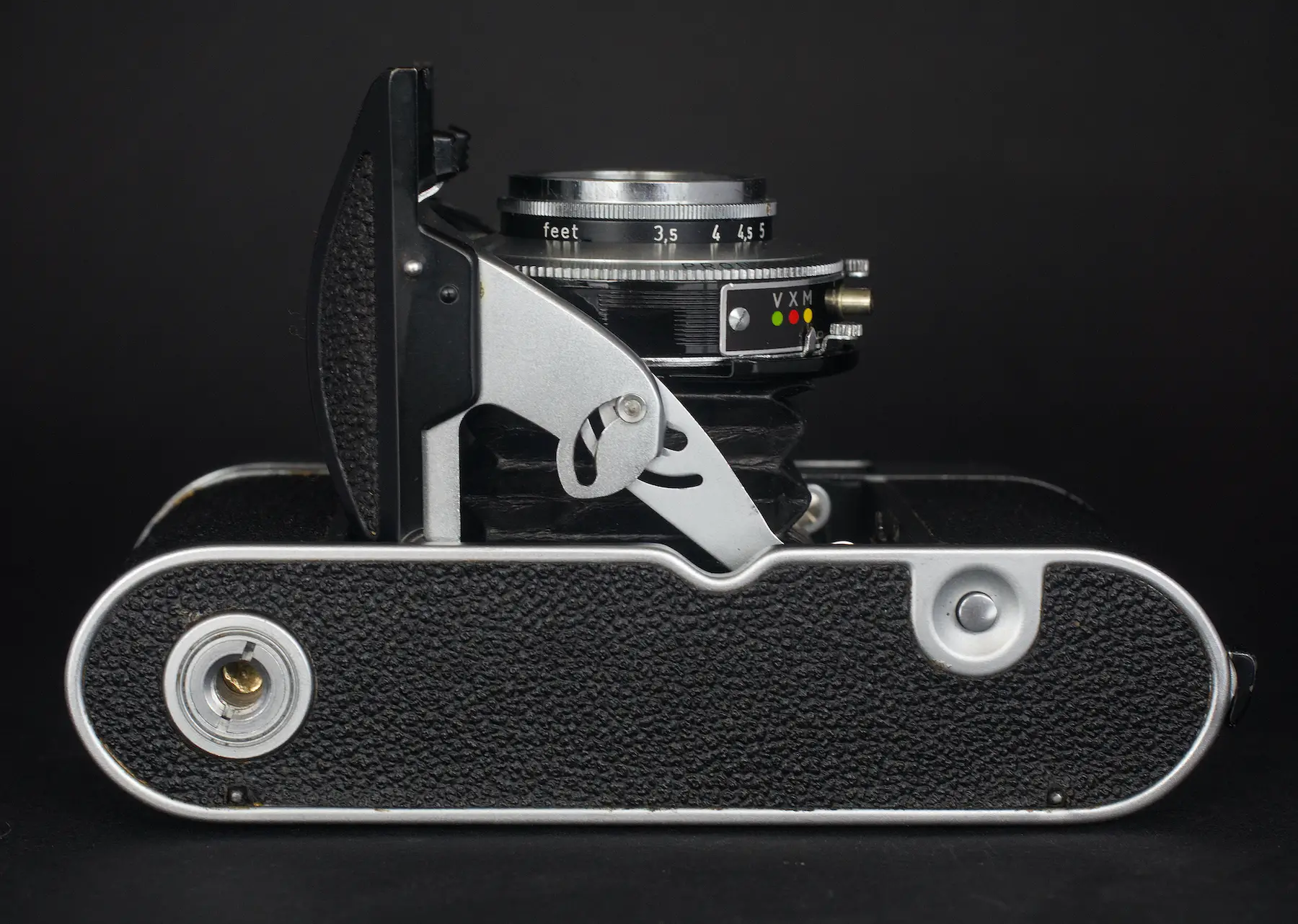
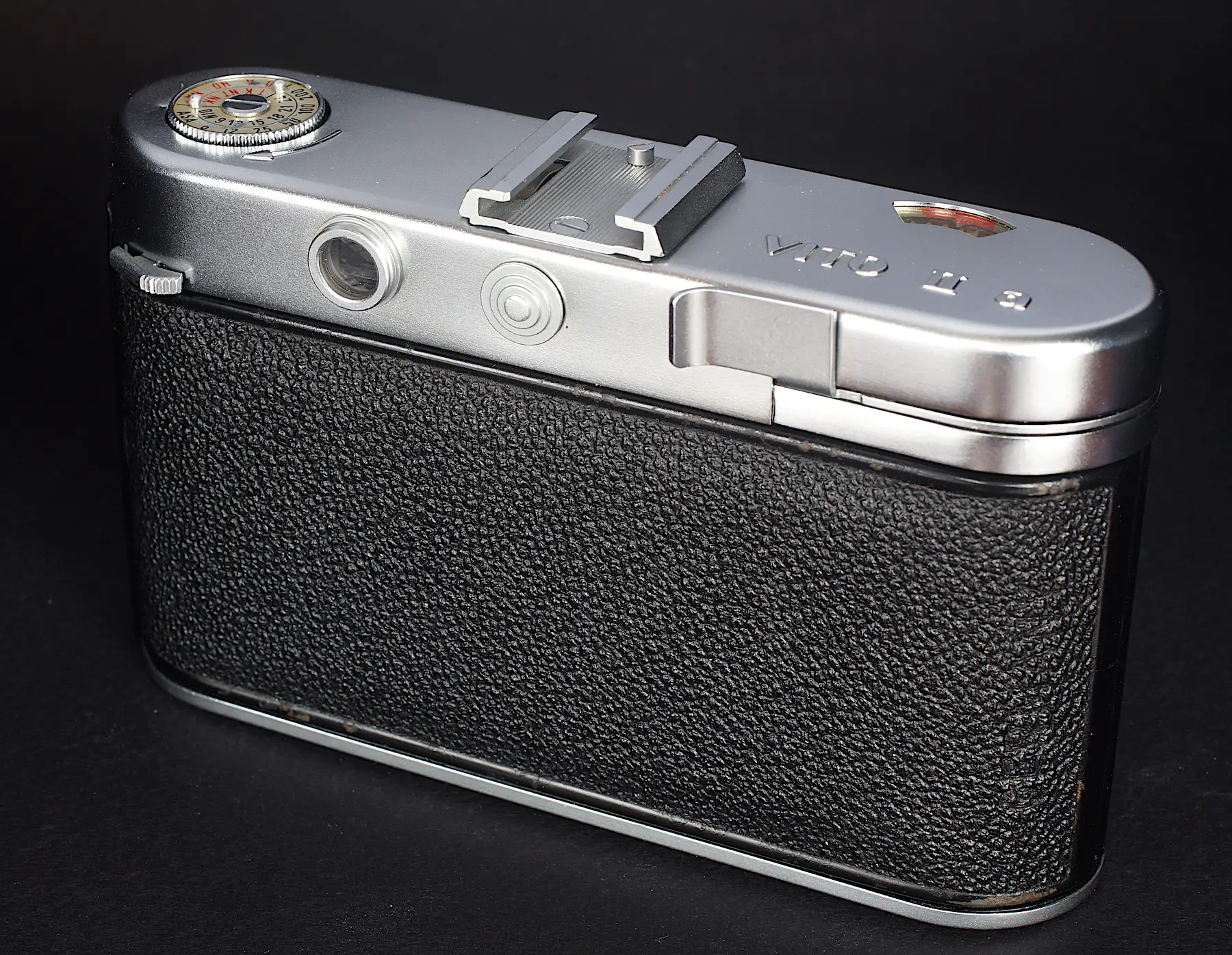
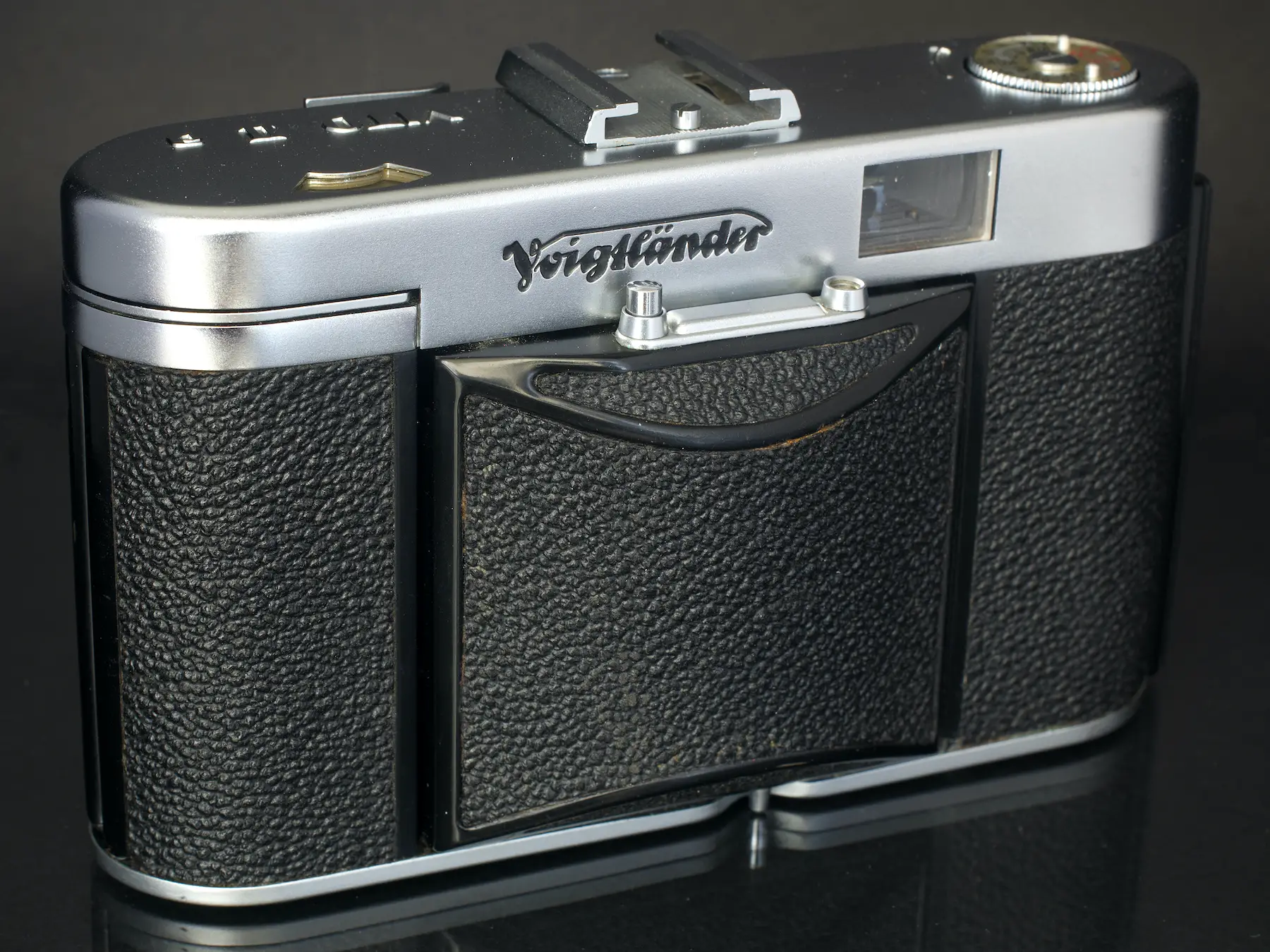
General impression.
Above all, the aura of quality shines through. The Voigtländer Vito IIa is a little gem of a camera, with finely made components and watch like engraved distance markings, clad in what feels more like the vulcanite found on a Leica than the more usual leatherette. It is a pleasure to simply hold in the hand, feeling solid and very well made, quite petite compared to the Retina IIc for example. Mechanically too, the quality shows. It opens smoothly and as it does so, the shutter release rises out of the edge of the door in a more forward position than the more usual top plate location. This falls under the fingers much more naturally and is one of the smoothest I have experienced, up there with my Retina IIc, my personal benchmark. The attention to these simple details, like the tiny studs on the base and the peg on the door to ensure it stands level on flat surface, is testament to the skill and experience that has gone into the design.
Even opening the back to load film is super neat. No bulky sliding or sprung catches, just a plain strip of enamelled metal that looks to be covering a hinge is levered up to release the back. This is definitely something that needs the instruction book if you are unfamiliar with the model, but so finely engineered and subtle.
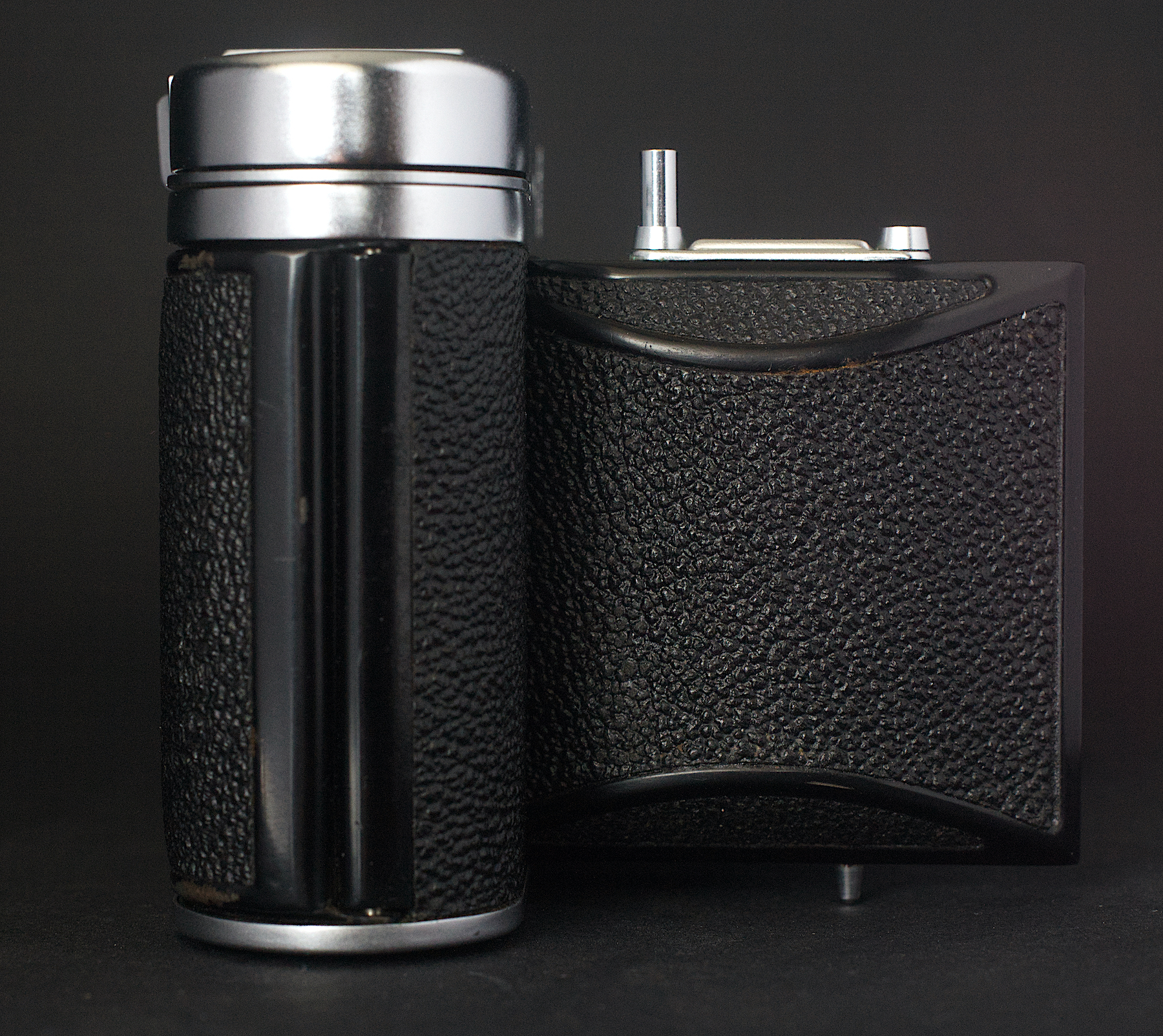
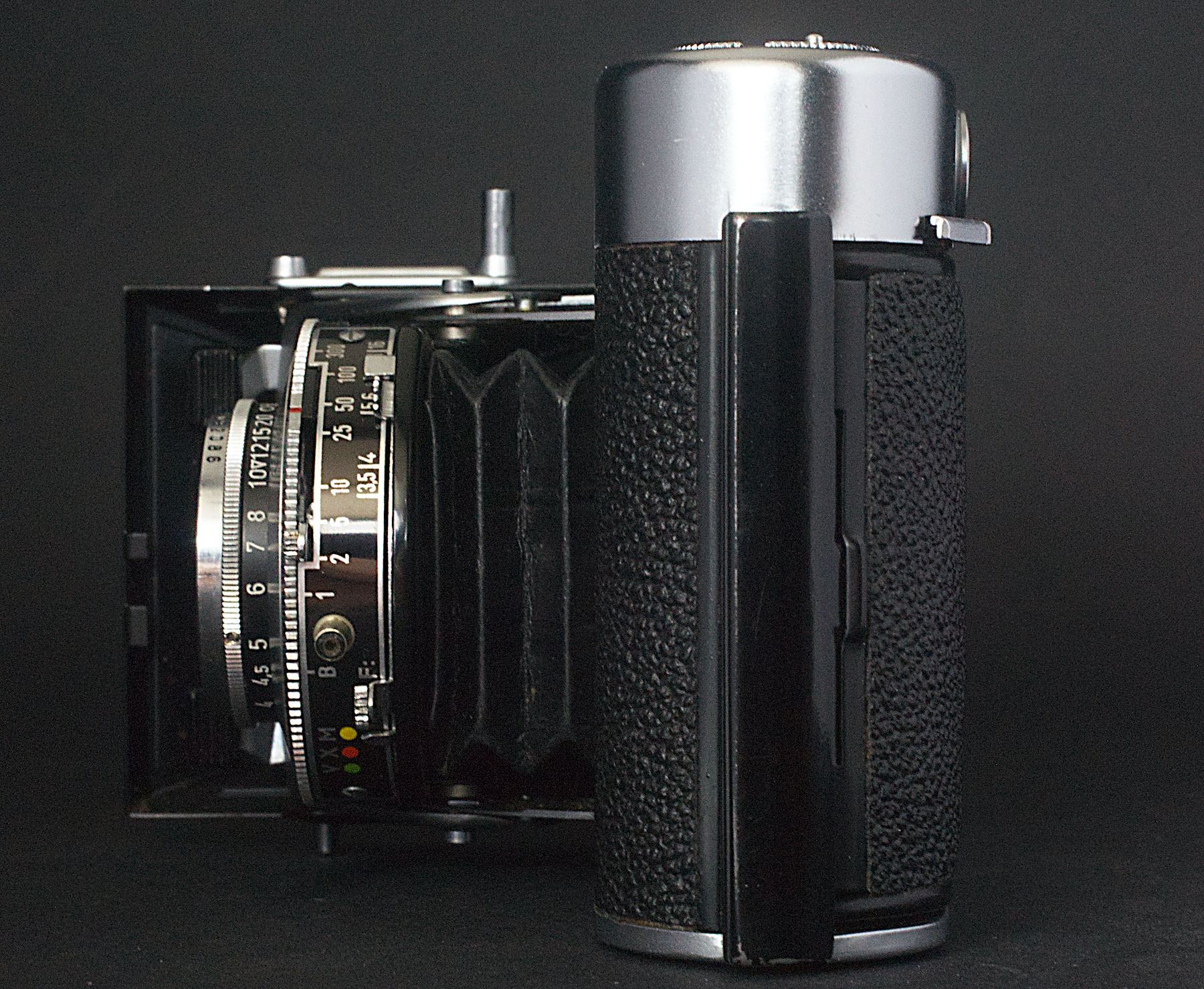
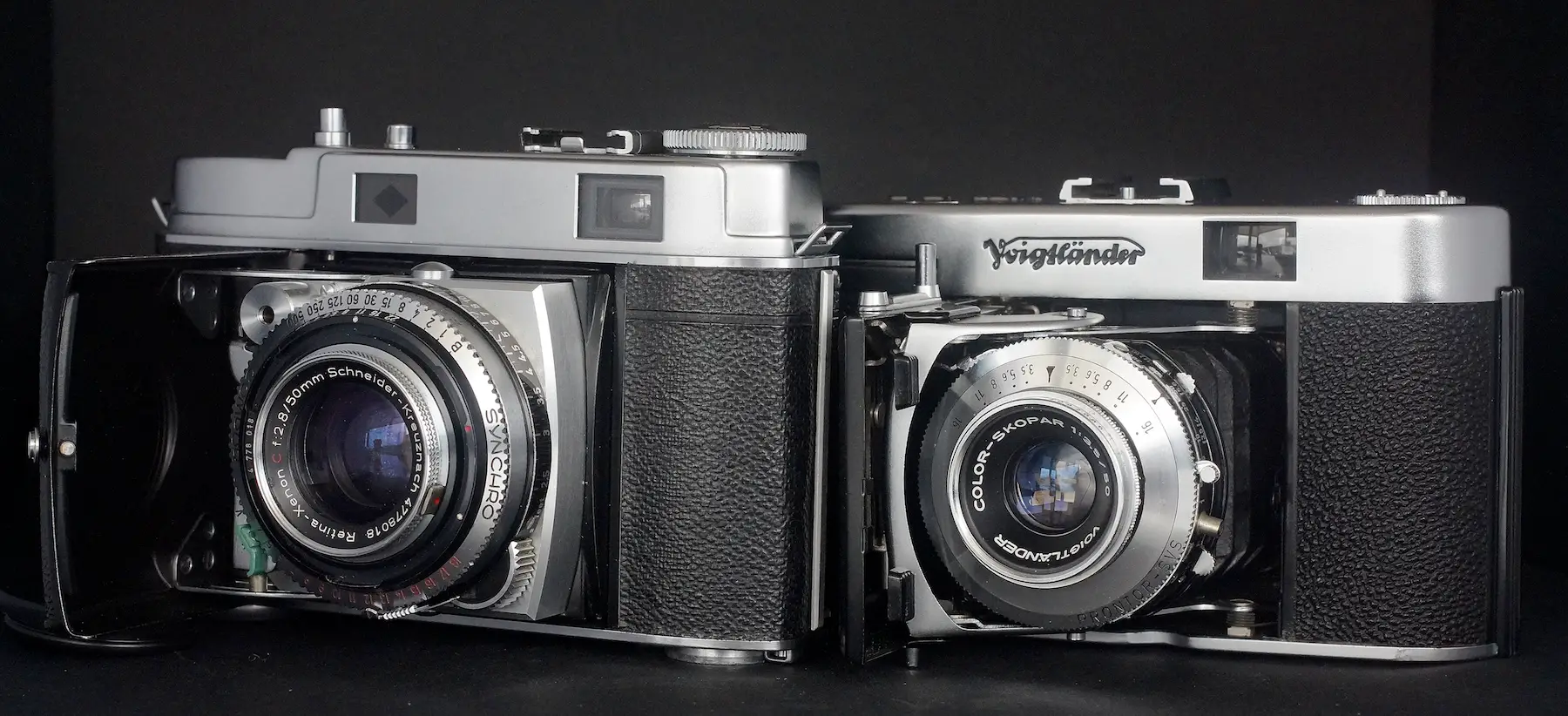
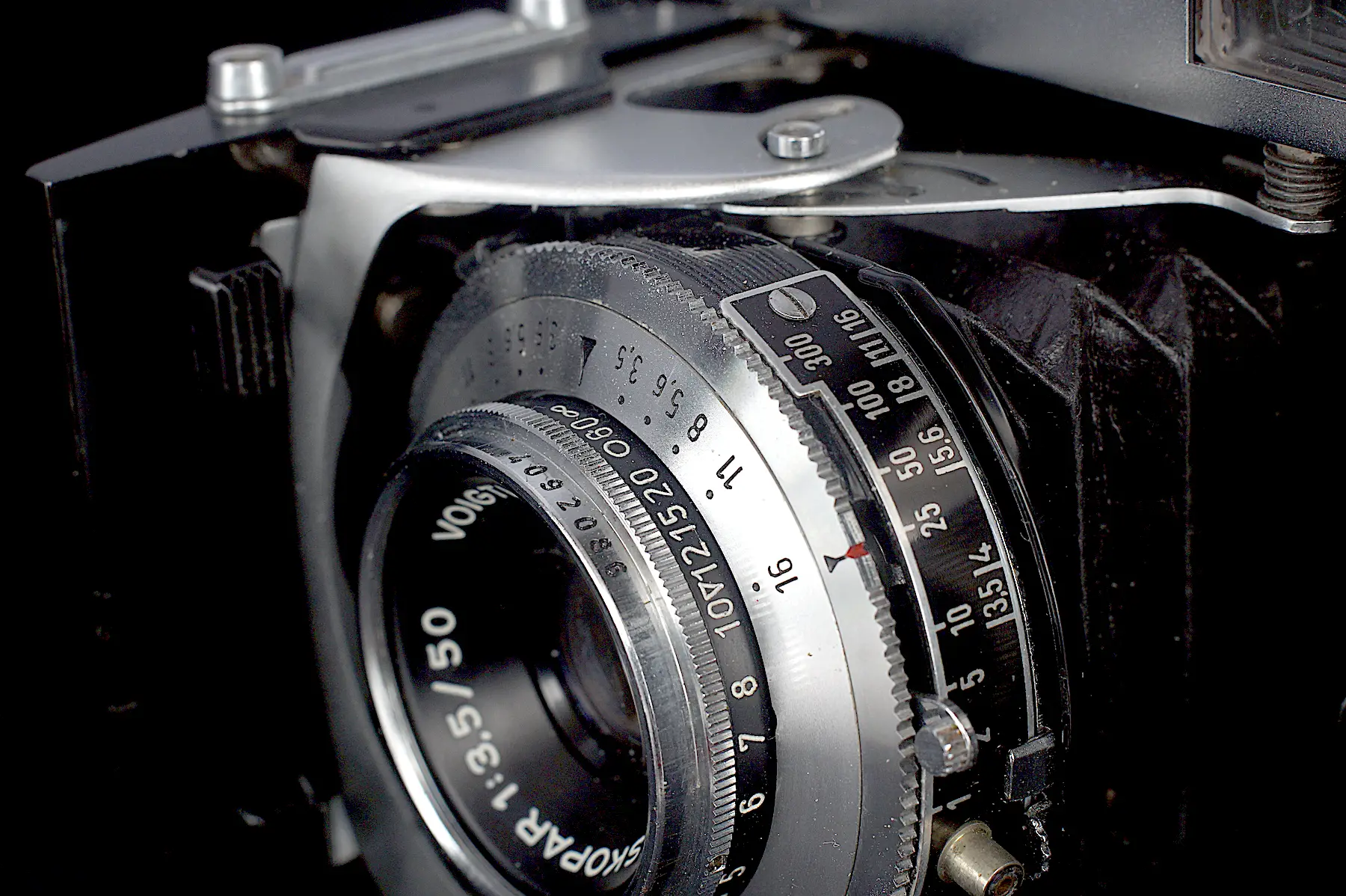
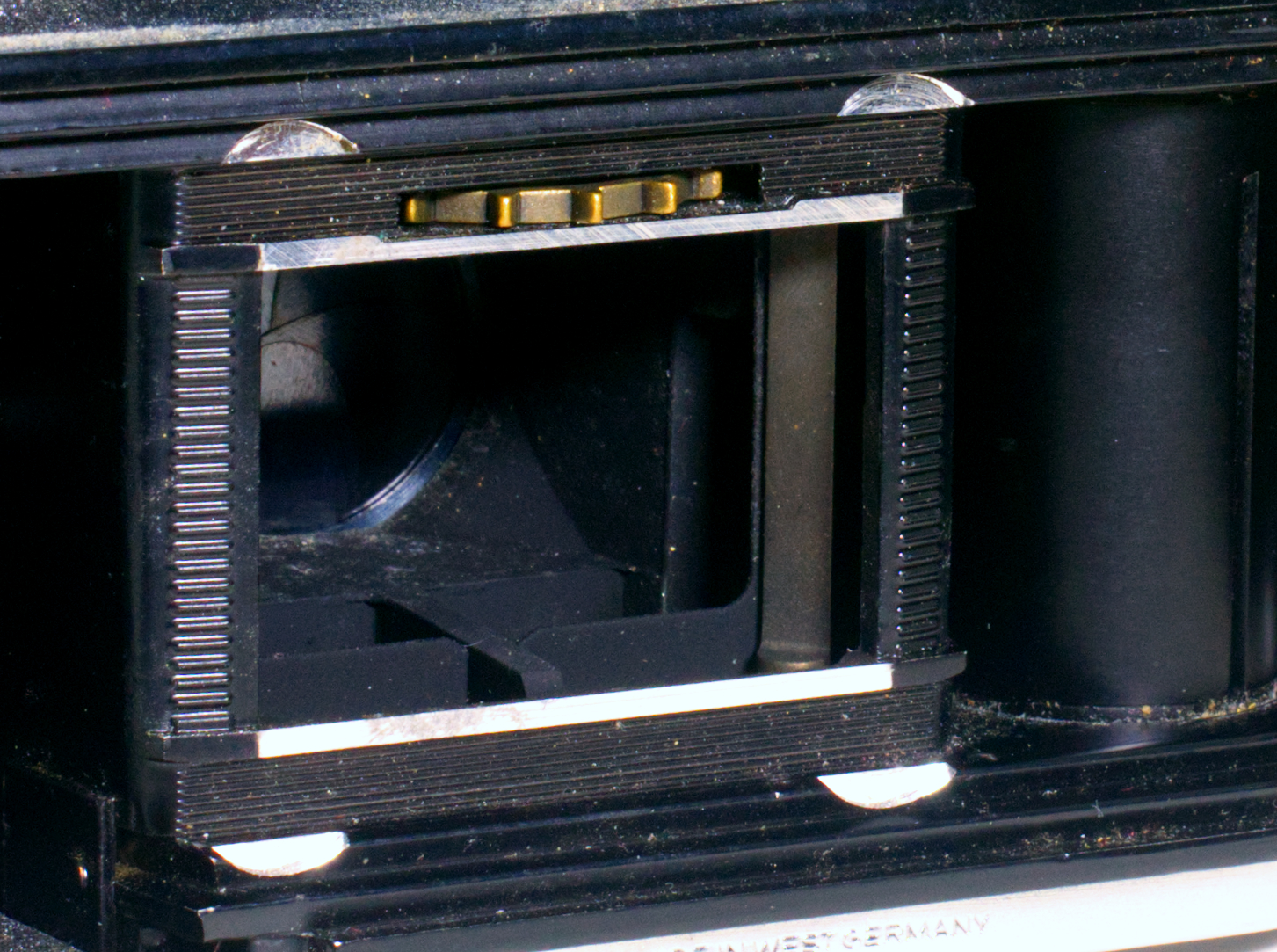
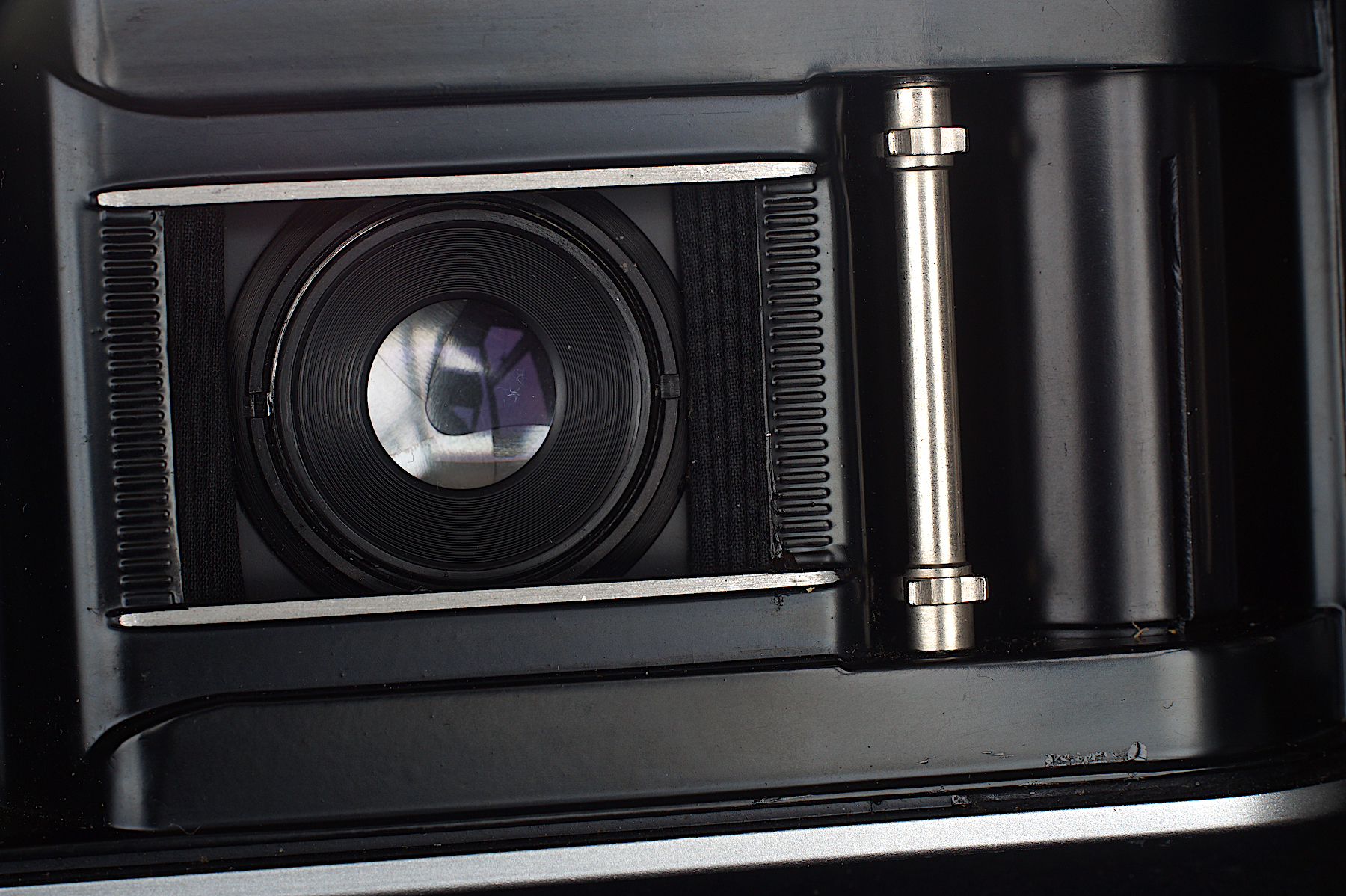
One quirk of the Voigtländer B/BL/BR/Vitomatic range was that the shutter is cocked and the double exposure prevention unlocked by a toothed wheel turned by the film perforations. Unless a film is loaded, the camera can appear to have a fault preventing the shutter from operating. This feature is found on the Voigtländer Vito IIa but here only controls the double exposure prevention device which is linked to an axle with toothed wheels at each end to engage the sprocket holes as the film enters the take-up spool, more usually used to transport the film. Without film, these wheels can be rotated manually if a dummy film isn’t available to allow the shutter to be cocked and fired. The IIa needs much less effort than the ‘B’ cameras, however, which have to overcome the stiff shutter main spring.
There is no denying, however, operation is fiddly, not because of the fineness of everything, but because of its era. Having to cock the shutter manually for example, and common up to this time, takes some getting used to but a few missed masterpieces concentrates the mind and it becomes second nature! My example of the bridge is a good example where I had a jogger and a cyclist perfectly placed in the near foreground. By the time I had cocked the shutter, however, they were long gone just leaving the solitary walker in the distance!
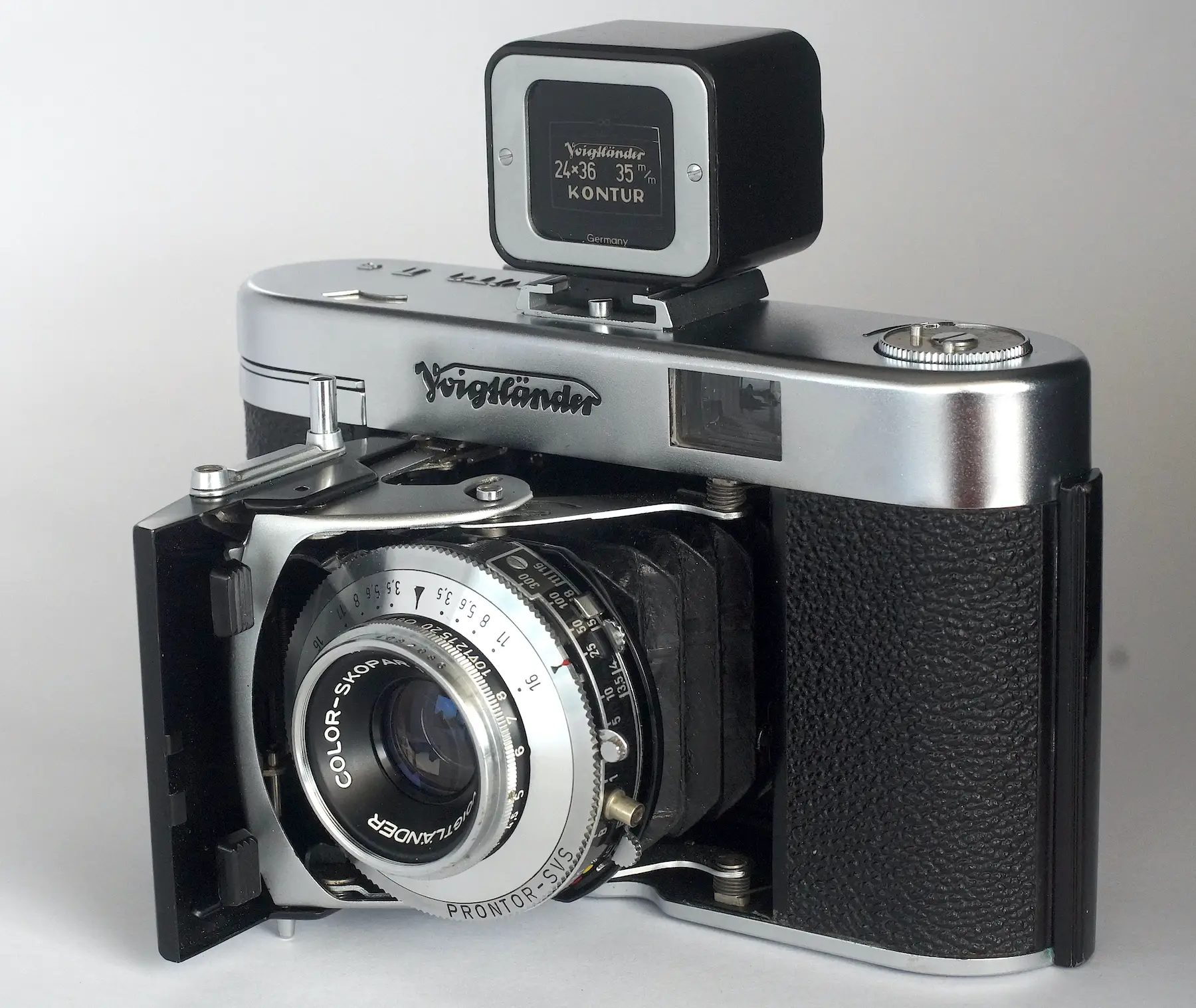
The Voigtländer Vito IIa finder, especially for a spectacle wearer like me is pretty tight, again typical for its day. I can just see the edges of the frame with care though so it is still workable and without glasses it will be no problem. Fortunately I have a Voigtländer Kontur finder which gets over the problem, a novel solution to providing a life size finder which is used with both eyes open. It relies on the brain’s ability to combine two images, in the way a 3-D image is viewed. One eye sees only the frame lines which appear superimposed over the subject, which is seen by the other eye.
The superb life size reflecting finders which were fitted to many of the following Voigtländer models up to and after the Zeiss takeover were in the future when this camera was made.
The lens is the Color Skopar, the later version of the long standing Skopar design, a four element Tessar type. Unlike the B series, which are helical focus with the shutter mounted behind the lens, the IIa is front cell focussing with the shutter within the lens. The folding design would make a helical focus mount too bulky presumably.
In use.
With the Voigtländer Vito IIa back from repair I ran my dummy film through to make sure everything was back in operation, which it was.
First off, film is loaded in the same way as any other camera taking standard 35mm cassettes. When basically in place, the back is closed and the frame counter set. This is done before pushing the rewind knob fully down, by pressing a button between the finder and wind lever to bring the letter ‘F’ against the counter arrow. Two blank exposures are made to bring up frame ‘1’ as usual which involves popping and pushing back the rewind knob, which releases the double exposure prevention device, and winding on. This is done twice and skips a couple of frames presumably in order to avoid exposing two out of focus shots of your feet before frame one comes up. The big advantage of the frame counter is that it counts back as you rewind so you can stop when it reaches ‘F’ again, leaving the leader accessible for processing.
From there on it is all as normal. Lack of a rangefinder means distances are estimated but two zone focus symbols, a triangle and a circle, are engraved on the distance ring so that setting f5.6 or smaller will give acceptable sharpness for subjects at 8 to 17 feet and 17 feet to ∞ respectively for more spontaneous photography. Exposure requires a seperate meter or Sunny 16.
The Voigtländer Vito IIa shutter is cocked with the lever on the shutter itself and the shutter release is smooth and positive, like the wind-on, which takes either one sweep or several shorter ones.
Voigtländer Vito IIa Results
I mostly use FP4+ which I process myself in Rodinal but I have used Rollei 400 ISO Infrared exposed as a normal panchromatic film with the IIa. The results show slightly coarser grain but more defined, while FP4+ grain is smoother and less obvious. I rate it at ISO100 and process in Rodinal 1:100 for 15 minutes at 20ºC with intermittent agitation. Other developers will give different results but I stick with Rodinal because it is almost immortal and I could well imaging an original bottle from the 1890’s still being useable, even if it would be black as ink.
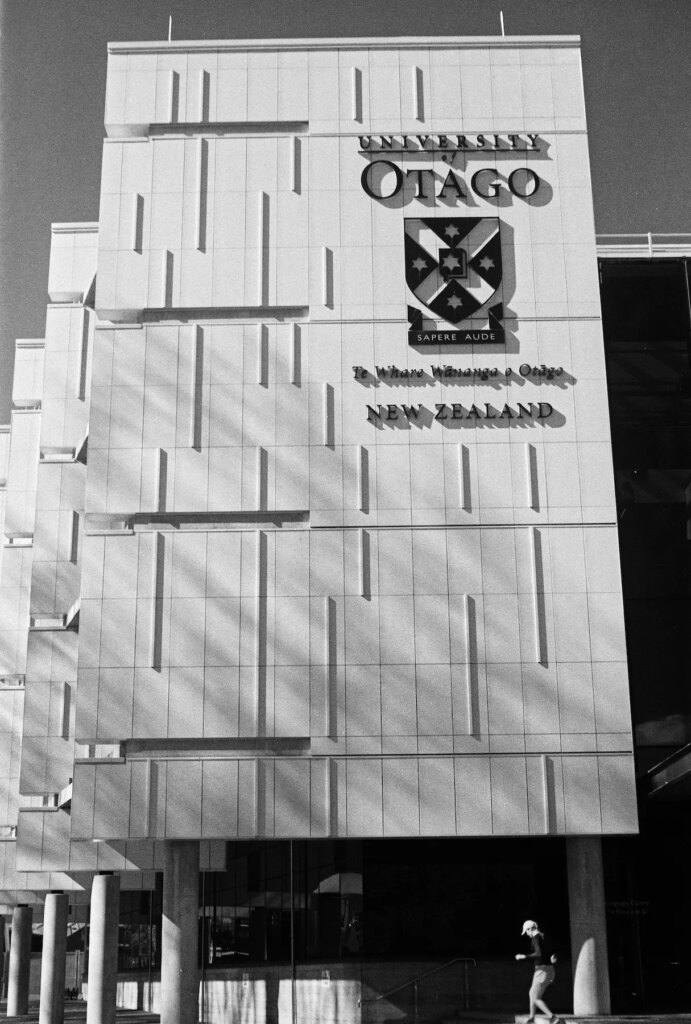
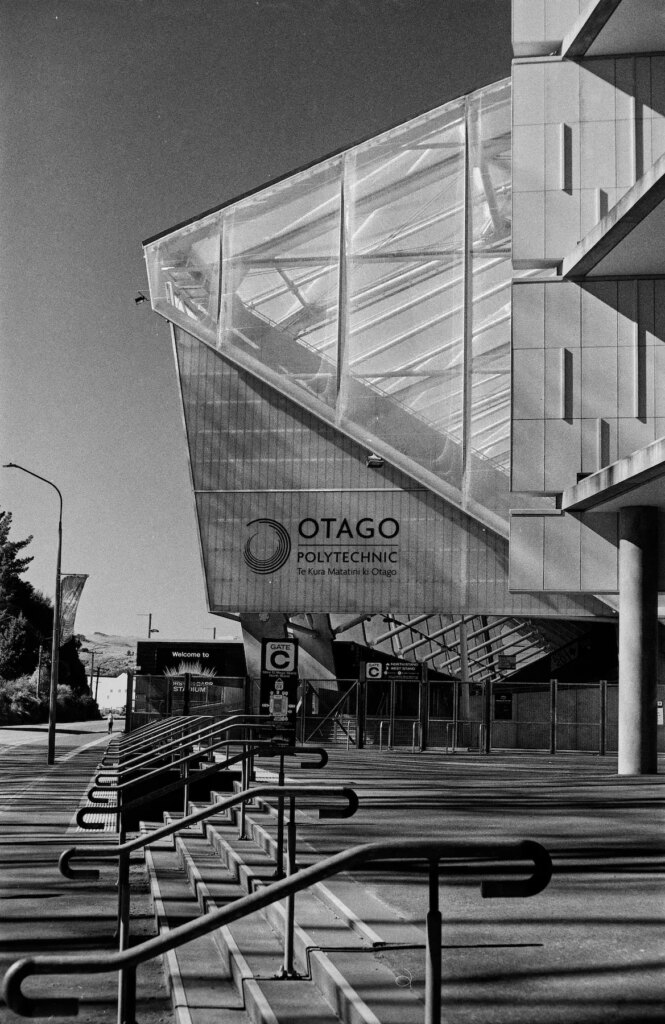
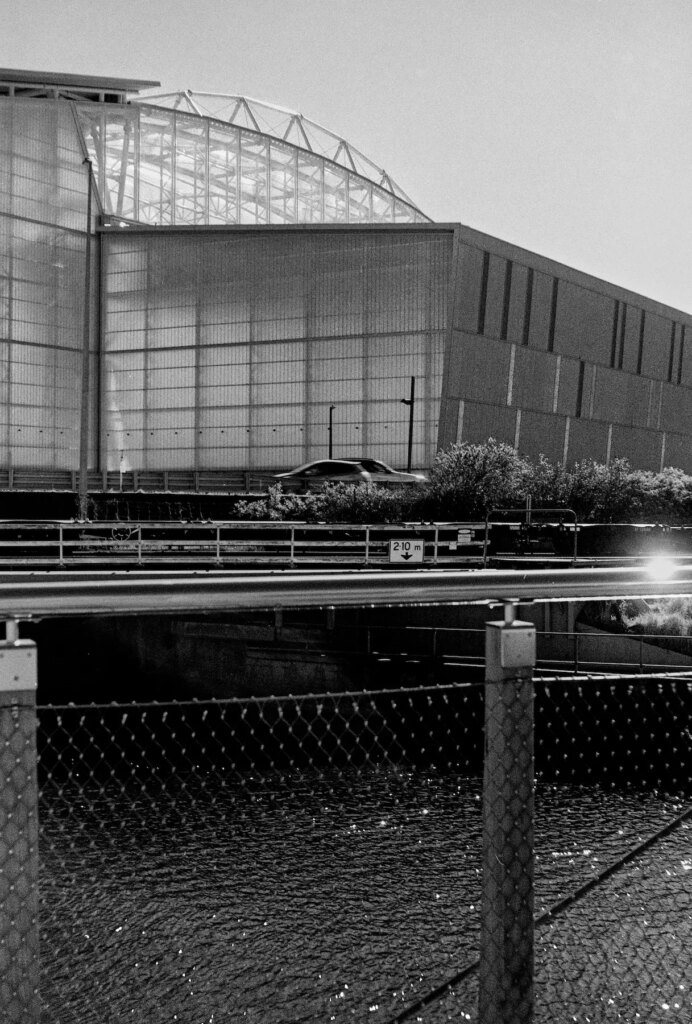
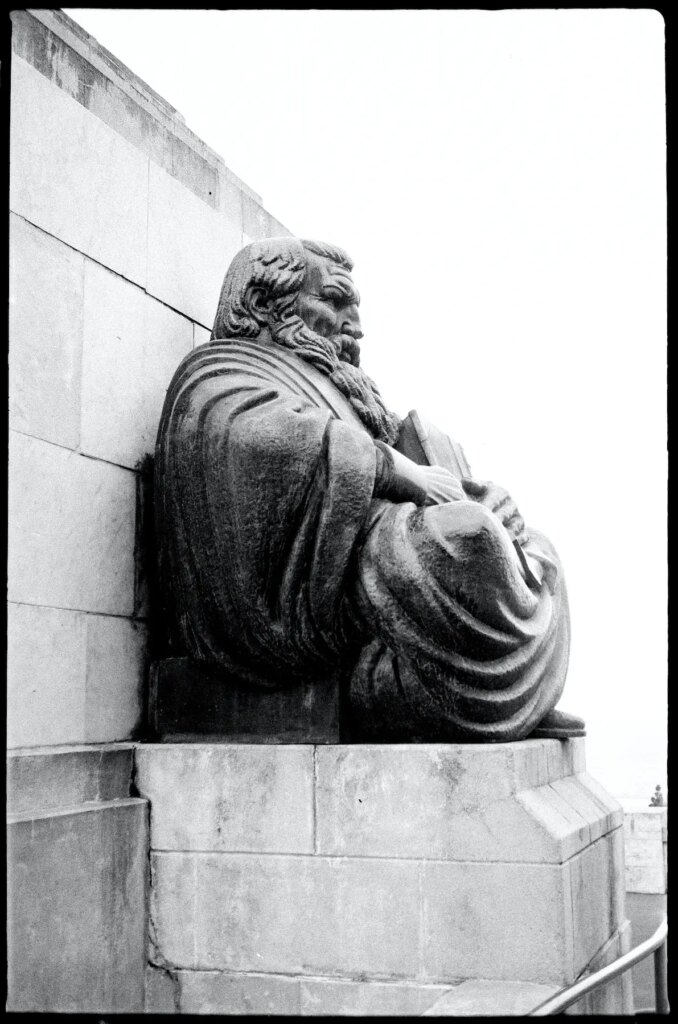

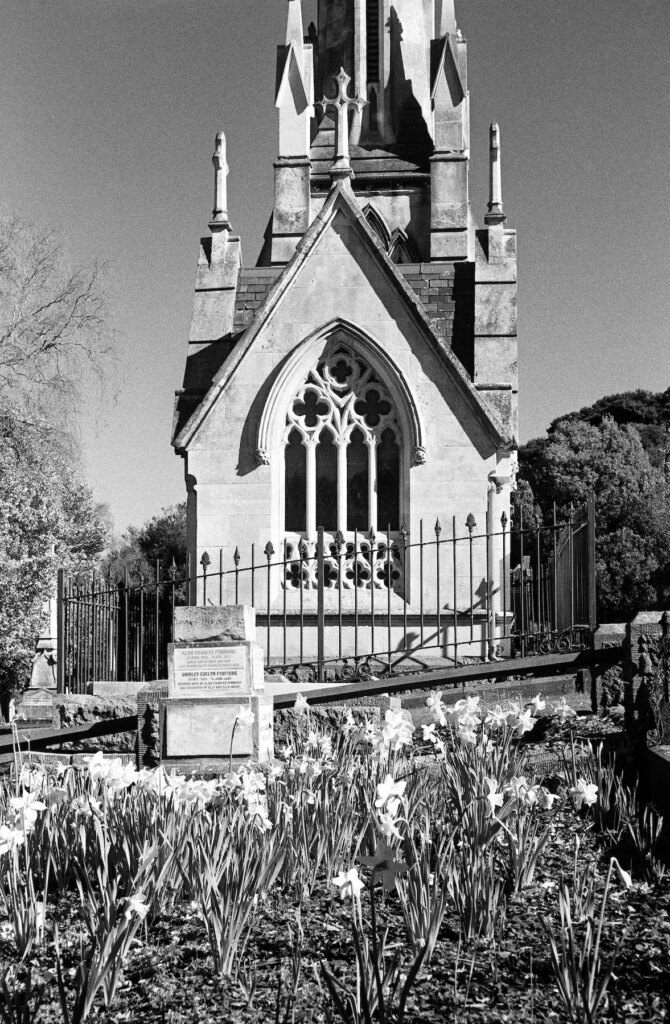
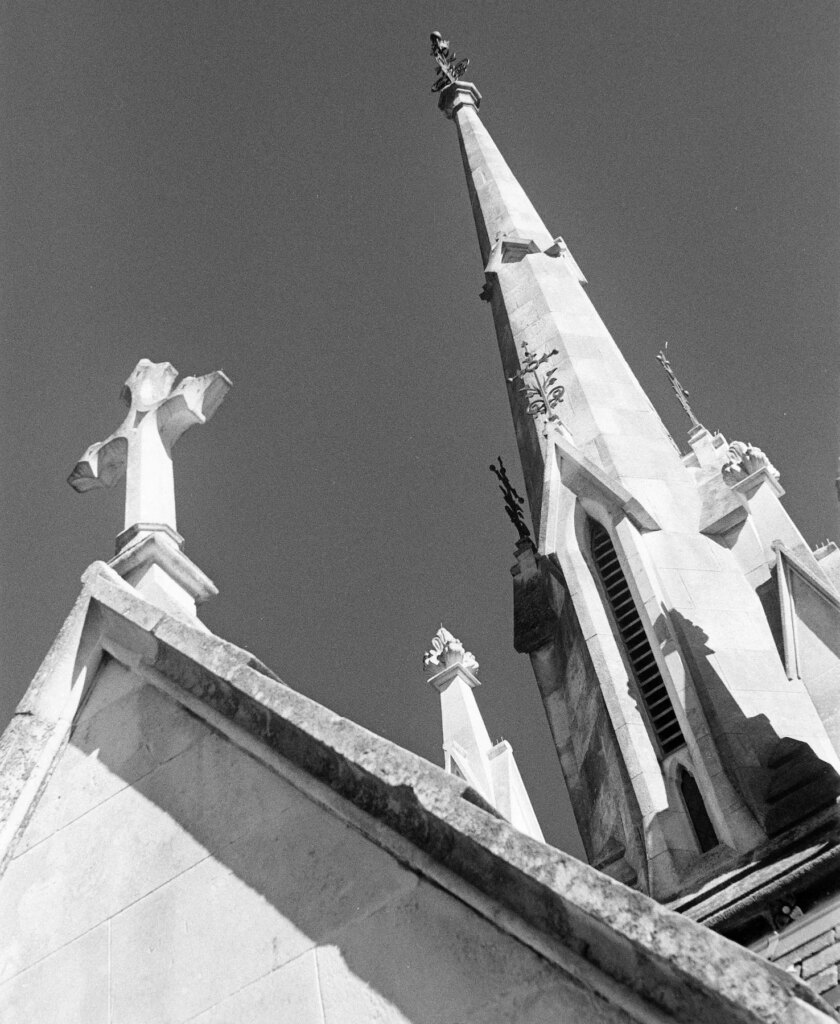
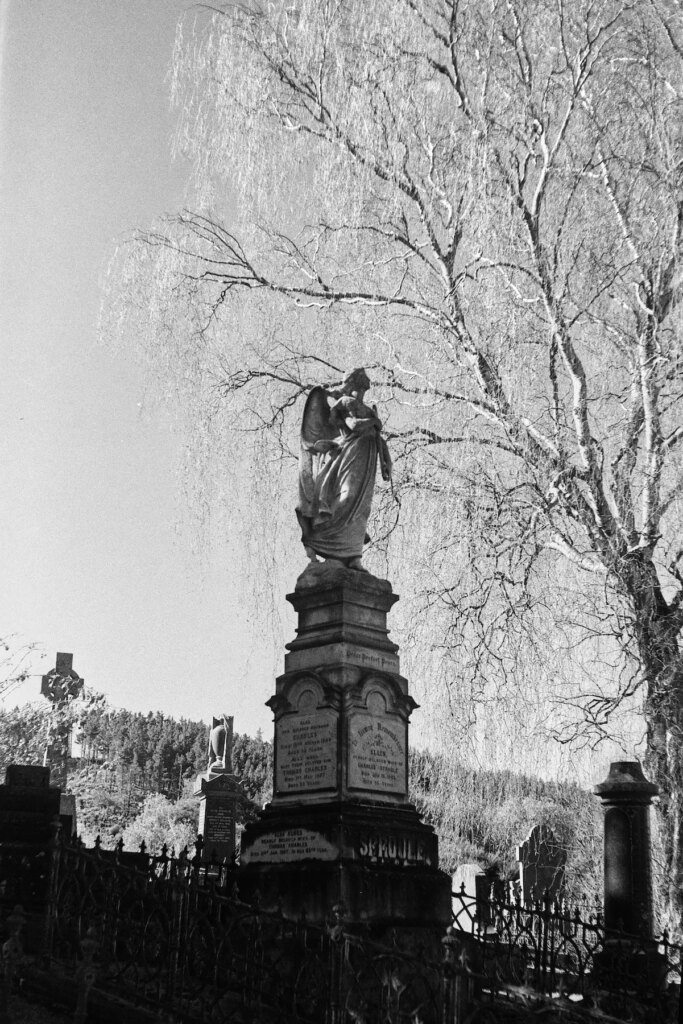
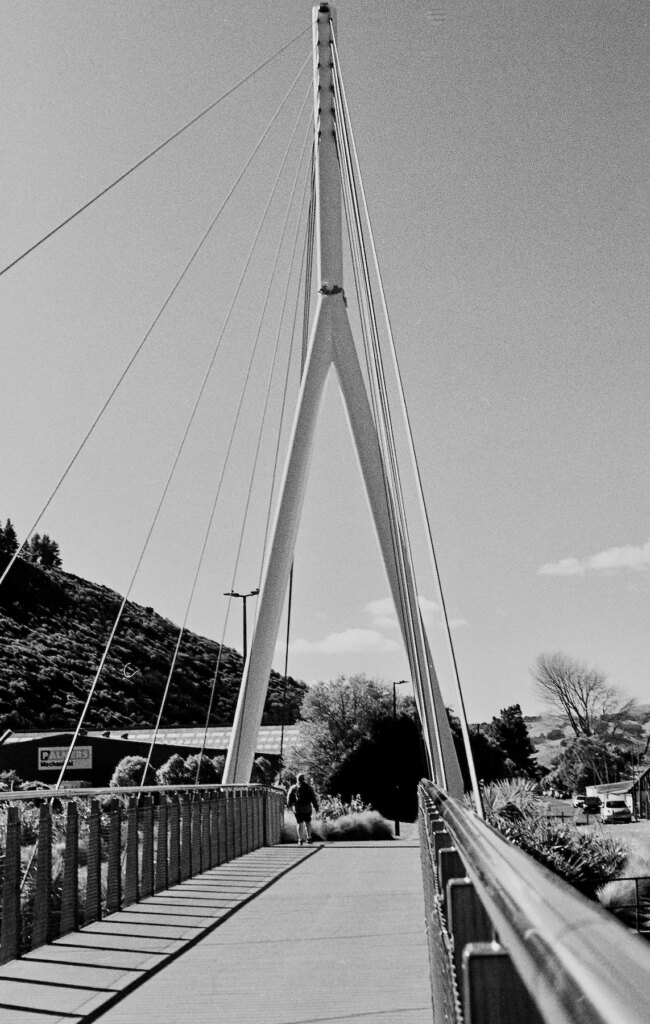
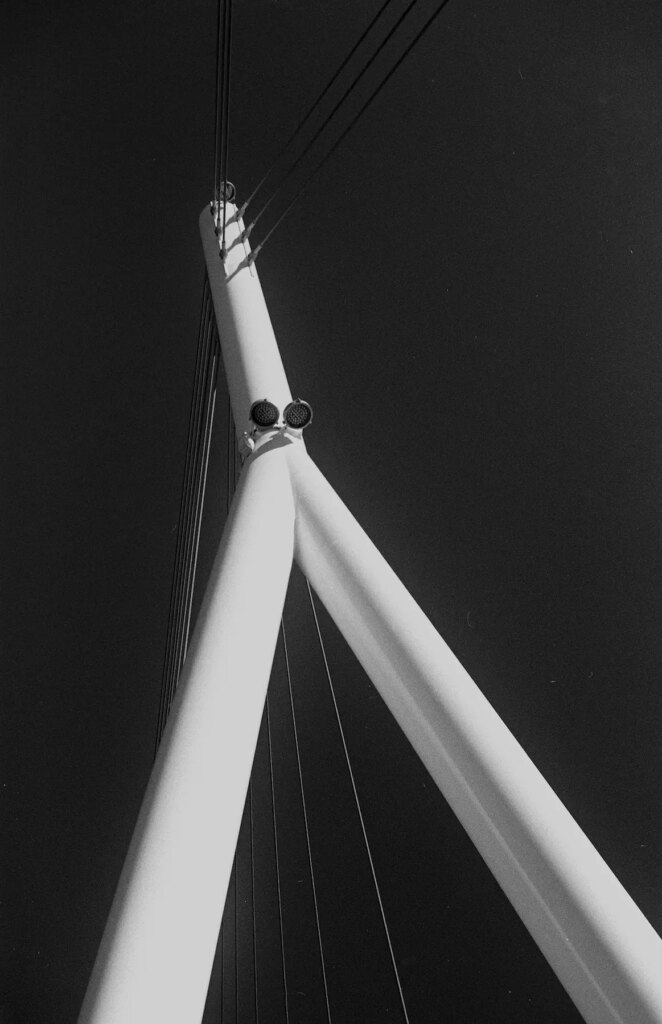
In conclusion.
I am enjoying using this delightful little Voigtländer Vito IIa again and I can see why I wanted one back in 1955. If it had a coupled rangefinder I would put it ahead of my Retina IIc having much better ergonomics. The smooth, well placed wind lever and the shutter release in particular fall so much more comfortably under finger and thumb, just like a modern lever-wind camera. And the feeling of solid precision is hard to put into words. I had a Vitomatic IIa for a while which did have a coupled rangefinder incorporated in the later, 1:1 reflecting finder but, excellent as it was, that model lacked the feeling of refined precision the Vito IIa possesses.
It demonstrates the level of refinement the German camera industry, and Voigtländer in particular, had attained before the arrival of the affordable SLR, plastics and electronics. It also shows how far photographic technology advanced through the second half of the 20th century when compared with the F801 for example. I understand that the price in 1955 of £25-£30 equates to around £275-£330 today so at the equivalent of £165 or so all in after repair costs this one is quite a bargain.
The results are all shot in and around Dunedin, down here in New Zealand.
(Photos of the camera and digitised copies of negatives are produced with a Sony A3000 with 55mm Micro Nikkor and adapters processed in Affinity Photo.)
Share this post:
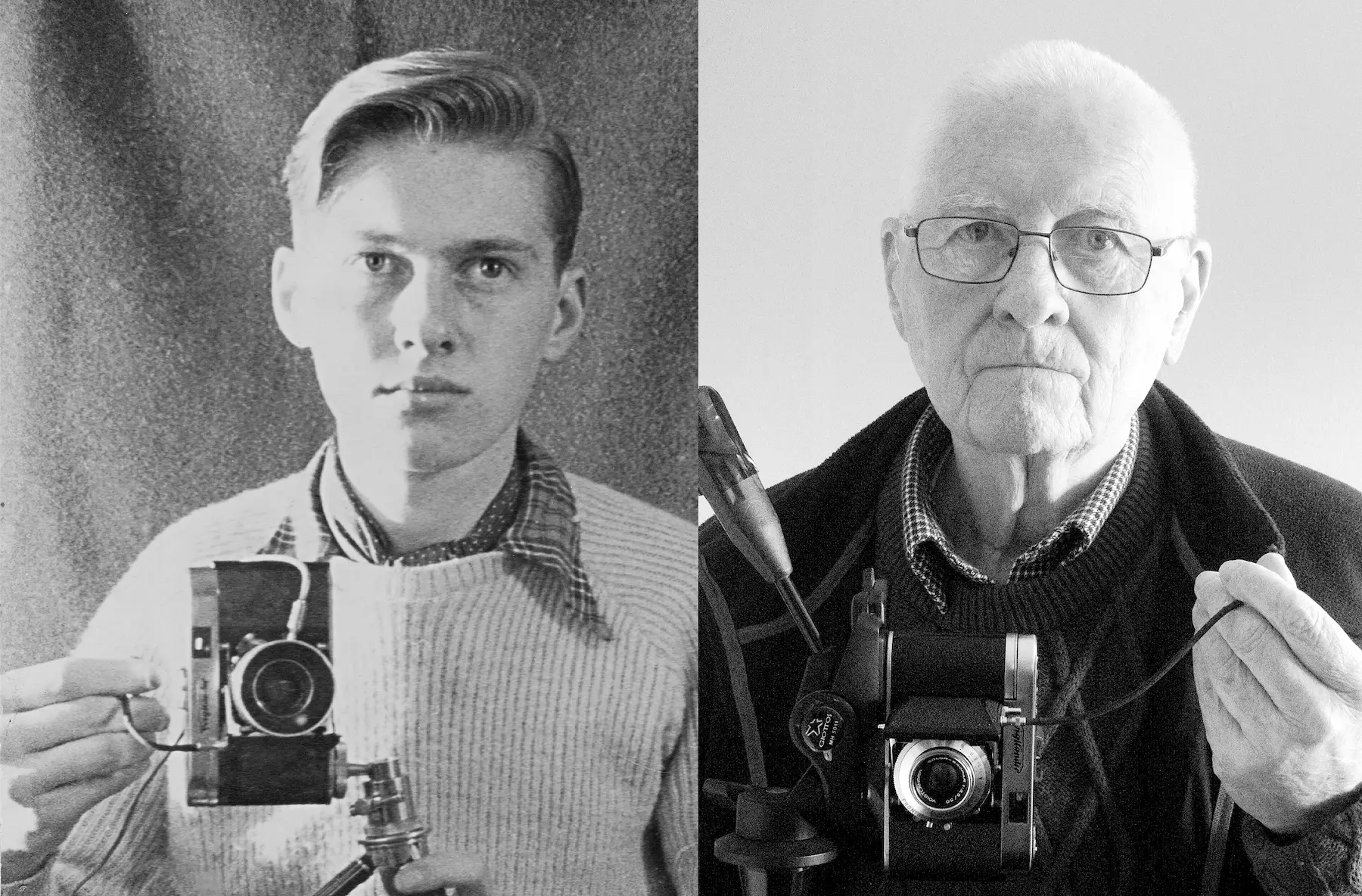








Comments
Martin on Voigtländer Vito IIa Review – Going Full Circle – By Tony Warren
Comment posted: 31/10/2022
Permit one question: Is it the same Dunedin where the (now retired) Retina specialist Chris Sherlock resides?
Thanks again and kind regards from the other side of the world
Martin in Austria
Comment posted: 31/10/2022
John Bennett on Voigtländer Vito IIa Review – Going Full Circle – By Tony Warren
Comment posted: 31/10/2022
https://www.provokr.com/wp-content/uploads/2021/07/ftsIlse_Bing_Self-Portrait_with_Leica_1931-1024x884.jpeg
https://i.pinimg.com/originals/d6/81/cc/d681ccb43329cc3784325148ee4af49a.jpg
Comment posted: 31/10/2022
Luciano Santo on Voigtländer Vito IIa Review – Going Full Circle – By Tony Warren
Comment posted: 01/11/2022
Tony Warren on Voigtländer Vito IIa Review – Going Full Circle – By Tony Warren
Comment posted: 01/11/2022
Clifton Dowell on Voigtländer Vito IIa Review – Going Full Circle – By Tony Warren
Comment posted: 02/11/2022
Comment posted: 02/11/2022
Jay Dann Walker in Melbourne on Voigtländer Vito IIa Review – Going Full Circle – By Tony Warren
Comment posted: 26/11/2022
Many of us 'oldies' still have cameras going a long, long way into our past. In my case, my lifelong interest (obsession?) with photography began five years after yours, in 1961 when I first got interested in a Kodak Brownie 616 my parents bought in 1943 for their wedding photos and later my first baby shots, taken outdoors on Kodak Verichrome film and contact printed by our local pharmacist. I still have all those prints but sadly, most of the negatives have long vanished into the dust of past disposals.
My first serious camera was a Yashica D TLR I bought new from a mail order agency in Montreal in 1962. I really I paid $35.99 for it but no tax, as my dad was a sales rep for this company and they kindly waved the tax as he fixed up the purchase for me on his business account, I recall as a 'sample' item. It served me well until th 1980s when I got into Rollei TLRS and it then sat on a shelf at home until 2001, when I gave it to a camera club in Ballarat (Australia). It worked well throughout and for all I know, it may still be in use by the club, even if 120 film prices and anything to do with lab processing in Australia now costs the earth and hardly anybody used MF much, or for that matter film of almost any sort. Sad, but such is life in the 21st century.
My 'involvement' with Voigtlander consists of a 1951 Perkeo I a friend kindly gave me a few years ago, the synchro-compur shutter model with the legendary f/4.5 Color Skopar lens, complete with a beaut original 'V' lens hood and a push-on yellow-green filter, a kit his now-deceased parents had bought new and used in all their travels over a 30 year period. It is an amazing camera to work with, simple and elegantly minimalist. Camera, film and my Weston Master V meter fit comfortably into a pocket of my backpack and I use it when I go trekking in the Australian bush. Horses for courses, as they say. Camera fit for purpose. Ideally so.
Your first two photos also reminded me of a celebrated selfie by Ilse Bing. Her work is well worth looking up, she was one of the early pioneers of 35mm photography in interwar Germany and had a long career after moving to the USA.
Best regards from Dann in Melbourne.
Tony Warren on Voigtländer Vito IIa Review – Going Full Circle – By Tony Warren
Comment posted: 26/11/2022
You are the second to comment on Ilse Bing, a photographer I was unaware of until now. I like the way she manges to incorporate a profile in her self portraits. Mine are just records really, the old one being from my university photgraphic society membership card. A bit of a poser in those days!
I process my own monochrome films, which I buy in tens from the UK where they go for a third of the price here in NZ. Colour negative is more reasonable, the Kodak budget films being quite good and half the price of the pro-oriented versions. A local dealer offers a reasonable cost C41 processing service.
I made an enjoyable visit to Melbourne for my 80th, just before Covid struck. It is a fantastic city and one I could happily settle in. The trams in particular are a real nostalgia blast for me. Growing up in a northern UK city, they were standard transport in those days.
Thanks for your comments, greatly enjoyed and appreciated. There are still some of us oldies out there who have been passionate about photography from an early age.
Best wishes. Tony.
Stephen McGonigle on Voigtländer Vito IIa Review – Going Full Circle – By Tony Warren
Comment posted: 06/01/2023
Tony Warren on Voigtländer Vito IIa Review – Going Full Circle – By Tony Warren
Comment posted: 07/01/2023
Martyn on Voigtländer Vito IIa Review – Going Full Circle – By Tony Warren
Comment posted: 10/10/2023
Comment posted: 10/10/2023